European vehicle-handling ports saw growth in vehicle vehicle volumes in 2017, however geo-political worries – not least Brexit – is causing concerns. Ports continue to invest but there are worries over future volumes and capacity levels.
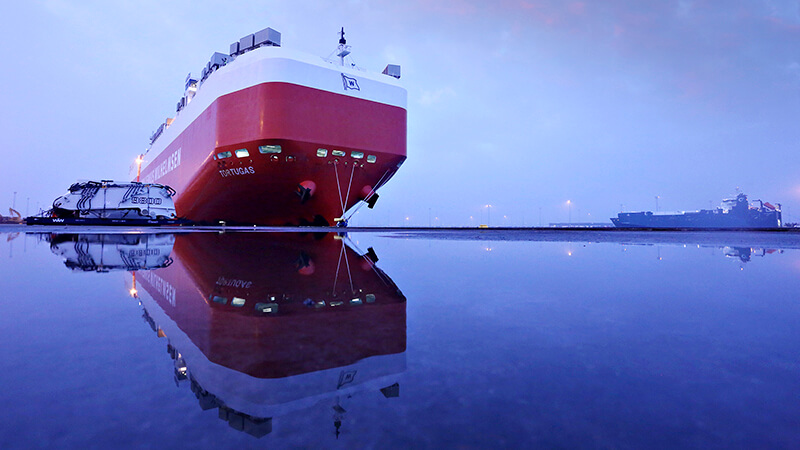 Vehicle handling ports in Europe and the companies providing services to them have been dealing with a lot of challenges over the past 12 months. More of them are being used as storage yards and are expected to provide sophisticated yard management, and with space for expansion an issue, capacity has become a big problem.
Vehicle handling ports in Europe and the companies providing services to them have been dealing with a lot of challenges over the past 12 months. More of them are being used as storage yards and are expected to provide sophisticated yard management, and with space for expansion an issue, capacity has become a big problem.
Elsewhere, political and financial upheaval across Europe has either taken its toll on vehicle flows in and out of the ports or led to new opportunities for trade with re-emerging markets, such as North Africa, Russia and Iran. The UK’s departure from the EU is a cause of both concern and hope to ports there, as it is for those handling transhipment volumes on the continent.
Strike action by stevedores in Spain, meanwhile, has caused some disruption in an otherwise burgeoning market for vehicle handling.
At the same time, ocean services providers are wary of the growing monopolisation of ports across the region, something which is affecting the bottom line despite their best efforts to remain in business at a time of historically low rates.
Where to put it all
Some of the main concerns expressed by ports surveyed by Automotive Logistics include finding more storage and handling capacity, especially given the growth that some of the bigger car handling ports are seeing, and at times when there are sudden spikes in volumes.
Antwerp Port Authority (APA) says that available space is the most challenging factor for its ro-ro terminals, which include Antwerp Euro Terminal and Sallaum Terminals.
“Not many European ports have the luxury of expanding,” says Ann de Smet, business development manager at the APA. “To meet with storage demand in the future, it is imperative that all stakeholders in the supply chain work together to smooth the nautical chain and enhance the terminal efficiency to create more flexibility and space.”
On top of the 985,324 new finished vehicles moved through Antwerp last year, the port also handled 252,854 used cars, pushing the actual volume handled to more than 1.23m.
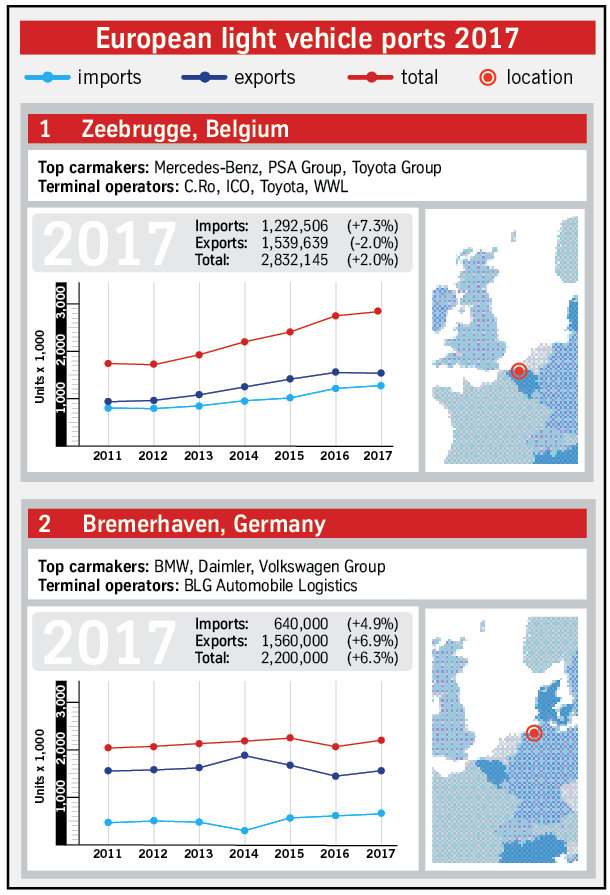 NYK’s stevedoring subsidiary, International Car Operators (ICO), which provides processing services for the majority (480,000) of new vehicles being moved through Antwerp, says there has been continuous growth there and at its terminals in Zeebrugge port, which handled 1.56m units last year. During last year, Zeebrugge held its position as the biggest car handling port in Europe, with 2.8m units – an increase of 2%.
NYK’s stevedoring subsidiary, International Car Operators (ICO), which provides processing services for the majority (480,000) of new vehicles being moved through Antwerp, says there has been continuous growth there and at its terminals in Zeebrugge port, which handled 1.56m units last year. During last year, Zeebrugge held its position as the biggest car handling port in Europe, with 2.8m units – an increase of 2%.
ICO agrees that capacity issues due to higher volumes have been a challenge. It completed a 30-hectare expansion at Zeebrugge last year and has plans for a further 30 hectares in 2018 as it prepares for handling 2.7m units between the two ports this year and for double-digit growth over the next three to five years. ICO says it expects the Nordic market to develop strongly over that period.
According to the port of Zeebrugge, Scandinavian ro-ro freight grew 4.3% in 2017 to a total of 14.9m tonnes.
In addition, ocean services provider Wallenius Wilhelmsen Logistics (WWL) has recently signed a concession agreement with the port of Zeebrugge to develop 49 hectares of land known as the Bastenaken West property, located in the inner port. The concession will be in place until 2043 and the company says it will nearly double its terminal footprint. WWL will invest about $20m over the next two to three years.
“The agreement marks the next step in WWL’s long-term commitment to the port of Zeebrugge, the largest ro-ro port in the world, and positions the company for continued growth and expansion all across Northern Europe,” says Ray Fitzgerald, president and COO of the WWL Landbased division.
WWL has expanded its operations at the port of Zeebrugge over the last 19 years to include vehicle processing, technical services for heavy equipment and yard management services. It says it has been seeking expansion opportunities within the port and the new concession allows the company to attract new business with vehicle-makers and other third parties.
“Both WWL and the port of Zeebrugge have experienced significant growth together over the last two decades and this expansion paves the way for an exciting future,” says Hendrik Sohier, terminal manager, WWL Zeebrugge.
At North Sea Port, which oversees developments at the ports of Ghent, Flushing and Terneuzen, Stephanie Dierick, the company’s policy officer, says that vehicle inventory has increased in the past year but the company has been ahead of any capacity constraints.
The port of Ghent signed a merger with Zealand Seaports in December last year to form North Sea Port, linking the Belgian and Netherlands’ ports.
Imports vs exports At the port of Bremerhaven in Germany, Europe’s second-busiest vehicle handling port, volumes were much higher than expected in 2017, according to Wolfgang Stöver, director of marketing and sales at BLG Logistics, the exclusive port operator there. He says the drivers for growth at the port were the global exports of German carmakers and a good European (and German) automotive market, but there were also seasonal effects, both consumer-led and climatic.
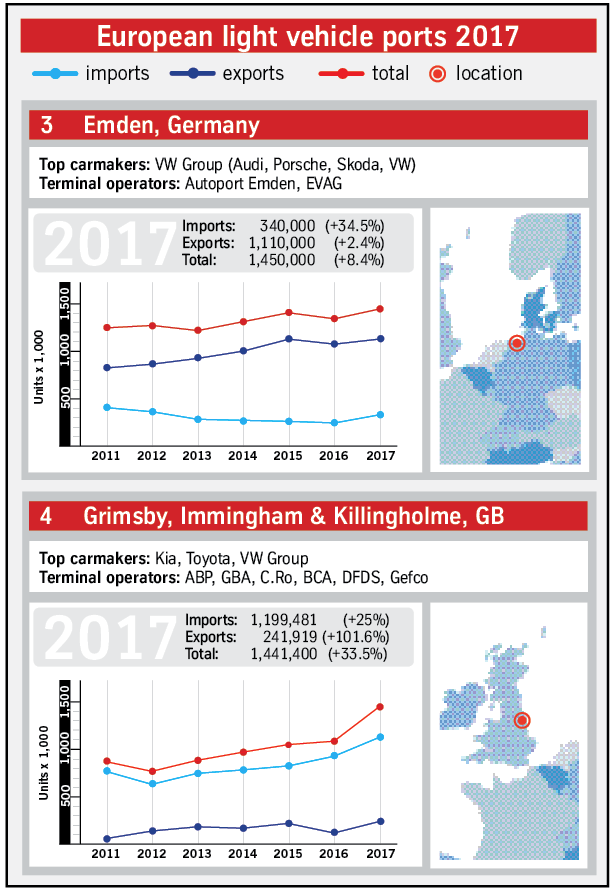 “We experienced high stocks of imported cars before the spring selling season as dealer yards were full with cars pushed out by the importers in December 2016,” says Stöver. “Later, in October and November, we had an irregular influence by two storms that led to the closing of railway services for four to five days each.”
“We experienced high stocks of imported cars before the spring selling season as dealer yards were full with cars pushed out by the importers in December 2016,” says Stöver. “Later, in October and November, we had an irregular influence by two storms that led to the closing of railway services for four to five days each.”
Storm Xavier hit Germany’s national railway in October, closing lines in the northern and north-eastern part of the country and affecting finished vehicle transport services. That meant cars moving for export from Bremerhaven were delayed into the port and bunched up. Consequently, vessel capacity could not keep pace with the influx.
WWL also says that the rise in inventory levels at Bremerhaven is causing problems.
“We have observed sustained congestion in this port over the past 12 months,” confirms Simon White, chief operating officer at WWL Ocean. “We understand this to be primarily [affecting] import volume and it is certainly a challenge felt by both the OEMs and lines calling at this port.”
Apart from that, BLG has been adding capacity and strengthening rail access.
“After creating more yard space by investing in a new multi-storey car park in 2016 (plus 5,000 yard slots), we focused the last two years on building up and optimising the rail network to and in the ports,” Stöver explains. “[This includes] a new marshalling yard closer to the terminal and new unloading stations and rail tracks. Furthermore, we decided to recruit 170 additional drivers in 2018 to join our company.”
BLG also operates the car terminal at Gioia Tauro port in Italy, the biggest ro-ro terminal in the country, where again, volume growth has been high thanks to new custom from FCA and VW Group, as well as the relationship with shipping line Grimaldi. Automar Logistics, which is part-owned by the Grimaldi Group, took a 50% stake in BLG’s vehicle terminal in 2016. The growth that has come as a consequence has led to a need for more space and better hinterland rail connections, says Stöver, and the company established a train service between FCA’s factory in Melfi and the car terminal at Gioia Tauro last year.
Back in Germany, at Emden, Europe’s third-busiest port, Joerg Tuitjer, head of operations for logistics and port services provider EVAG, says that capacity usually becomes an issue during the peak seasons of spring and autumn and that 2017 was no different. While discussions with carmakers are held every year, Tuitjer acknowledges that there is no permanent solution to these annual trends.
Another complicating factor when it comes to capacity at the ports is increasing model variation.
“To have more and more different models with different lengths makes the handling, storage and loading onto a vessel more complicated and this trend seems not to be at its end, as OEMs want to be present in all segments and models,” explains Tuitjer.
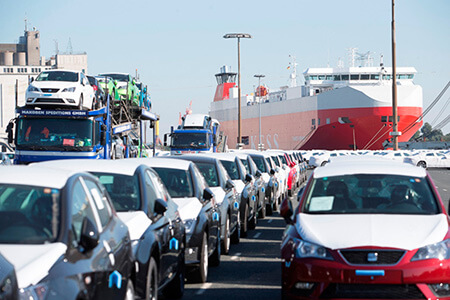
EVAG saw a growth in imports last year of more than 31% and has increased capacity at Emden with a new area that can accommodate 10,000 cars. It is also in “good” negotiations over a new berth for deep-sea vessels, says Tuitjer.
Rail driving volumes in Spain
Down in Spain, the development of more intermodal links for finished vehicles is driving numbers up at the port of Valencia.
“Last year the port of Valencia handled some 42,000 units by rail, an increase of 15% from 2016, and we expect to increase this figure in the coming years,” says commercial manager at Valencia Port ZAL, Jorge Civera. “At the end of 2017, we received our first train of imported cars from Italy to be distributed in Spain.”
The vehicles were delivered to the port by Grimaldi Lines (the main marine services provider calling at Valencia) and were moved to Madrid by rail on a service that Gefco is reported to be providing. The unique feature about the service is that to date, rail has not been used to handle import consignments of finished vehicles, although rail is now an established player in the export market.
Valencia is also benefitting from night rail services for the first time, allowing it to handle trains around the clock.
Among the ocean routes feeding this business, the port has two high frequency services with Italy: one to Livorno, running six times a week and another to Salerno, which runs three times a week.
The Port Authority of Valencia (PAV) now manages three vehicle handling ports: Valencia itself, which processes the majority of the traffic (523,797 units), Sagunto (to the north) and Gandia (to the south).
Ford, which has a local manufacturing base at Almussafes, is by far the biggest customer overall, with 384,550 cars moved through the port (4.18% up on 2016). Fiat came second at just under 85,000 units last year. However, Toyota also increased traffic there by 27.5% last year to 67,822 units.
Civera says the main challenge in 2017 was in coping with increased demand from brands in a short space of time, and so it has developed new areas in the ports to handle this. Now, the port authority has almost 1m sq.m dedicated to vehicle handling, with 560,000 sq.m of that at Sagunto (Ford moved significant traffic there back in 2015 when Grimaldi Lines added the port to its calls in Spain). Further to this, the port authority is going to pave an additional 40,000 sq.m in Sagunto for new vehicle traffic and invest more than €31m ($38.4m) to connect the port with the Spanish rail network between this year and 2021.
Valencia port, meanwhile, has 412,000 sq.m of space dedicated to vehicle handling and Grimaldi is going to build a vertical storage unit there for 11,000 vehicles this year.
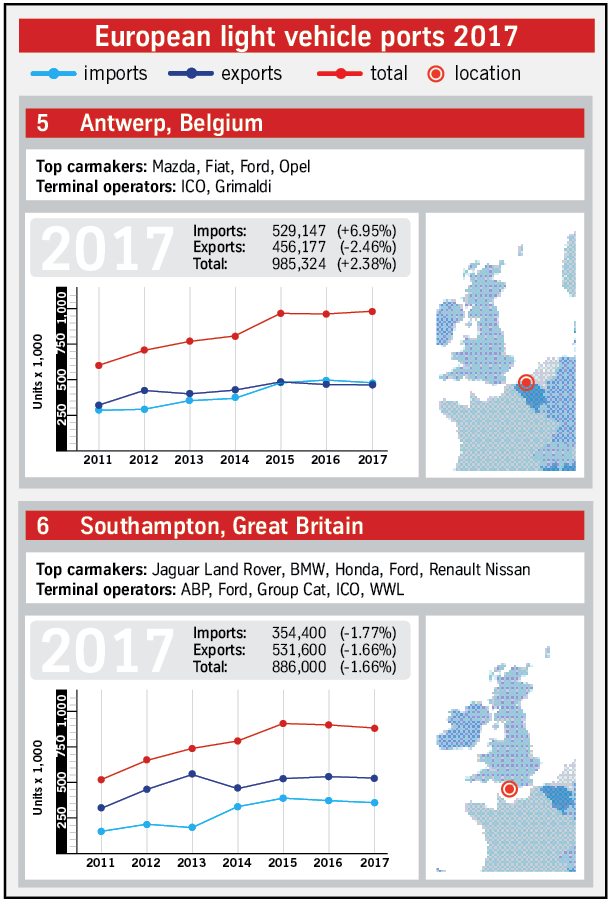 As at Valencia, new rail links have also been a factor in driving up traffic at the Spanish port of Barcelona. Lluís Paris, commercial manager at the port, says the increase in rail activity to and from central Europe has helped to establish Barcelona as a southern European hub.
As at Valencia, new rail links have also been a factor in driving up traffic at the Spanish port of Barcelona. Lluís Paris, commercial manager at the port, says the increase in rail activity to and from central Europe has helped to establish Barcelona as a southern European hub.
The port has finished setting down three new 600-metre rail tracks with three different gauges on the Príncep d’Espanya pier, which will be lengthened to 750 metres by August this year, according to Paris. The port of Barcelona is also lengthening four tracks in the Dàrsena Sud area, which can now handle all Spanish gauge traffic to the port.
In addition, the port has established new areas for reception and delivery on both terminals which, along with gate automation, has improved access and speed of throughput for finished vehicle trucks calling at the port.
This move to increase non-road links is similar to that being undertaken at the Belgian port of Ghent, incidentally, where North Sea Port is supporting initiatives to move goods from road to other modes and has established a train connection for goods including vehicles to Lithuania and on to China. It has also established a barge connection to and from the port of Zeebrugge for vehicles and containers.
CarEsmatic in Barcelona
In terms of oceanside deliveries, the port of Barcelona is particpating in the CarEsmatic project, set up by the European Commission’s Connecting Europe Facility (CEF) programme and designed to improve the existing Motorways of the Seas (MoS) services between the port of Barcelona’s Autoterminal and the ports of Koper in Slovenia, with participation from Neptune Shipping Lines.
The programme aims to move vehicle traffic off the roads and onto short-sea routes (in line with MoS objectives), as well as to support the movement of electric vehicles by putting some of the investment into portside charging facilities. Overall investment in the programme is €17.1m.
According to the EC, CarEsmatic will develop access infrastructure at Barcelona and Koper to improve port access and railway connections, with the aim of cutting congestion on the roads and promoting a cleaner automotive industry. The project will also contribute to the MoS objective of enhancing intermodality by upgrading the internal railway network of Barcelona port to the UIC rail gauge.
Current short-sea ro-ro services to Barcelona include daily calls from Grimaldi, twice-weekly calls by Neptune Lines, and additional monthly calls from Euro Marine Logistics (EML), Grimaldi and Suardíaz. The port answers to deep-sea services from Höegh, MOL, NYK, K Line and Eukor.
Spanish terminal operator Bergé, which has operations at the ports of Santander, Tarragona and Vigo and handles around 1m vehicles a year, has also witnessed an increase in demand for vehicle handling. Among the gains in traffic it saw last year was a contract with EML to manage vehicle stevedoring services at the port of Santander, mainly for Renault and Nissan vehicles. Bergé already handles around 400,000 vehicles through the port and the contract with EML has meant an additional volume of 160,000 imported and exported vehicles a year between 2017 and 2019.
In February this year, the Bergé Automotive Logistics division was awarded a contract with Volkswagen Group to provide logistics management and storage of imported Volkswagen, Audi and Škoda vehicles, as well as for Volkswagen Commercial Vehicles. Bergé will be handling an additional 180,000 units in the first year through port facilities at Santander and Tarragona, as well as its inland facility at Ciempozuelos, near Madrid.
The company will be providing haulage services between the vehicle handling terminals and logistics centres.
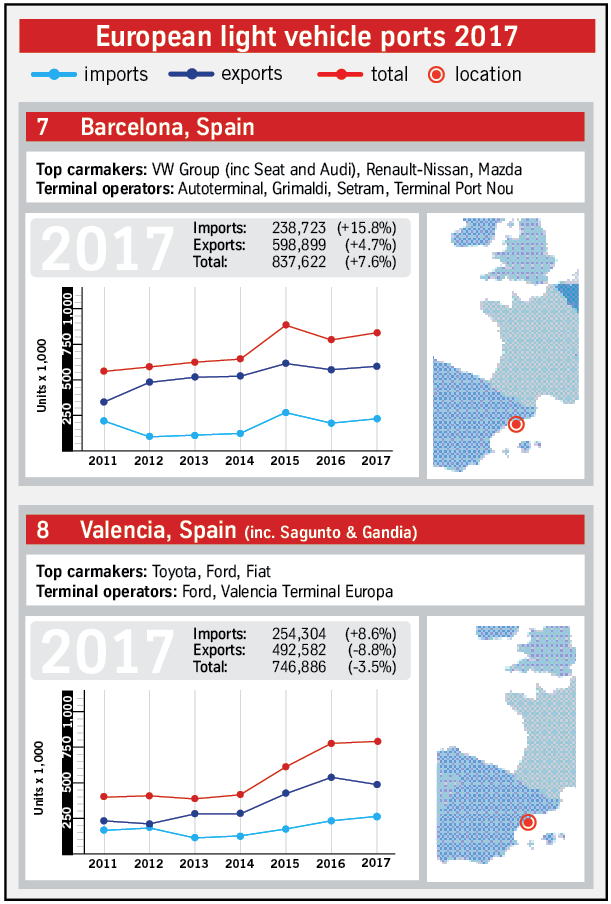 “We manage a fleet of 400 trucks for the haulage last year of more than 600,000 units between port compounds, logistics centres and dealers’ networks,” explains Jordi Casals, managing director at Bergé Maritima. “Our facilities include more than 2m sq.m with capacity for 100,000 units among our compounds in Madrid and the port terminals of Santander and Tarragona. Our centres are equipped with 20,000 sq.m of workshops for PDI and PPO [vehicle customisation] services.”
“We manage a fleet of 400 trucks for the haulage last year of more than 600,000 units between port compounds, logistics centres and dealers’ networks,” explains Jordi Casals, managing director at Bergé Maritima. “Our facilities include more than 2m sq.m with capacity for 100,000 units among our compounds in Madrid and the port terminals of Santander and Tarragona. Our centres are equipped with 20,000 sq.m of workshops for PDI and PPO [vehicle customisation] services.”
Over at the port of Setúbal, which is Portugal’s leading finished vehicles handling port, figures for 2017 show that automotive traffic last year generated the best ro-ro results at the port for a decade. The upswing in ro-ro movements is due in part to the production of the T-Roc model at VW’s Autoeuropa manufacturing plant at nearby Palmela in the last three months of the year. This helped add 26,204 units to overall exports.
In total, Setúbal handled 223,671 finished vehicles in 2017, boosting overall ro-ro traffic by more than 23% compared with the previous year.
Space in the UK
The main vehicle handling ports in the UK are also adding capacity, as was seen last year when ABP added storage to its terminals in the Humber region, in the north-east, and at Southampton, in the south.
“Southampton saw the completion of the next phase of development of the port’s multi-deck storage (MDS) facilities with the completion of both the sixth and seventh car parks, which together cost £25m [$35.6m] and added around 8,000 spaces to the storage footprint,” says Clive Thomas, head of commercial and property at ABP in Southampton. “The port plans to commence the development of a further two MDS facilities in 2018, which will together add a further 8,000 spaces, taking the site footprint to over 60,000 spaces.”
Likewise, in the Humber region, where ABP has ro-ro terminal operations at the ports of Grimsby and Immingham, it is also investing to expand. There the company has acquired an additional 65 hectares of land and will start to develop the new storage sites this year.
GBA, which has terminals in the Humber among its other UK operations, has also been investing. GBA’s commercial director, Cale Judah, says that it began operating a vehicle preparation centre for BMW at Killingholme in 2017, as well as securing a contract for business out of Southampton port. It has also renewed its contract for services with VW Group through the port of Sheerness and opened a multi-use PDI centre for volume and dealer-elect delivery inspection services. Last year, GBA handled 1.8m vehicles across its UK operations and invested £500,000 in technology to support operations under the control of its innovation division GBA Technologies, which was launched at the beginning of 2017.
The port of Bristol, meanwhile, has responded to rising demand for room by purchasing additional land for car storage at Royal Portbury Dock, according to Tony Dent, director of automotive trade at the Bristol Port Company. Dent says that despite the rise, the port has kept inventory largely in line with capacity, helped by the prompt reaction of OEMs including FCA, PSA/Vauxhall and Toyota in adjusting incoming volumes with demand. Among the positive developments at the port, Dent believes there has been good communication between those OEMs, the terminal operators and Bristol Port Company.
At the port of Tyne, which continues to be the regional entry point for Renault-Nissan, EML has launched a new weekly Iberia Express ro-ro service connecting vehicle ports in the UK, Belgium, Spain and Portugal. Tyne recorded an increase in vehicles handled last year of around 10,000 units.
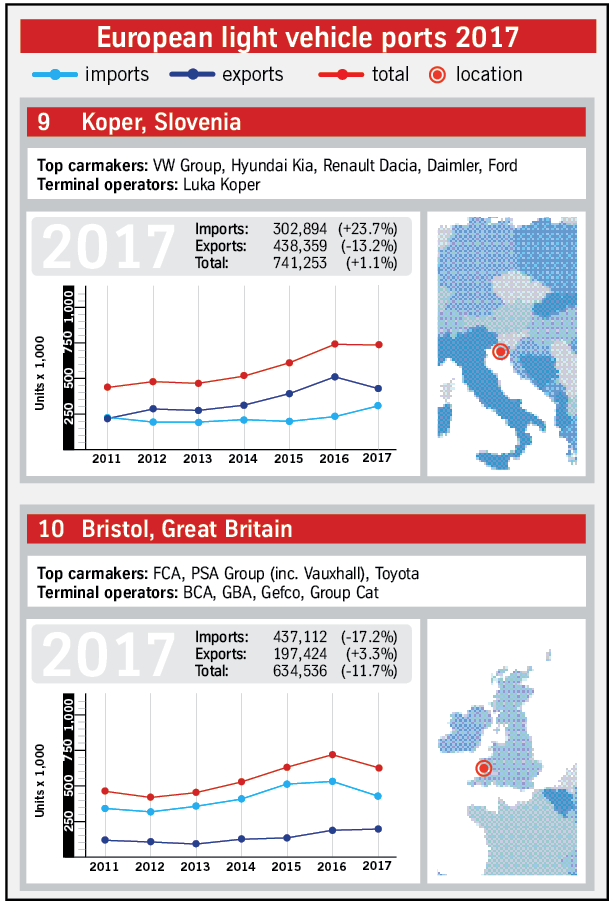 Returning trade
Returning trade
In Turkey, too, there are plans for adding capacity. There is an ongoing expansion project at Autoport, which is located at Yeniköy, in the north-east Kocaeli region, and handles 20% of finished vehicle throughput across the Turkish ports. Last year, it processed 393,000 units. Autoport is adding space for 11,000 units and working on a PDI project that will let it handle 100,000 units per year.
A spokesperson for Autoport says the port will start using its additional capacity by the beginning of next year, with the PDI service going into operation by the second quarter of 2019.
Volume pick up is expected at Efesan port because of renewed trade with Russia and Iran (see below). With greater European trade expected, the port says it will increase vehicle handling by 8% this year.
Efesan port has a multi-storey customs bonded car parking area with capacity for 4,500 vehicles, as well as open storage for a further 2,500. It is in the process of adding a car park that will hold a further 13,000 vehicles in 2019.
“Through this project, we are targeting services for 450,000 vehicles per year,” says the spokesperson. “Our capacity will increase by up to 50% of what we have now, once the second phase is complete.”
Geopolitical impact
One of the other big issues affecting the ports and ocean service providers this year has been the geopolitical landscape. The changing political and economic conditions across a number of regions in Europe, including the UK, Iran, Russia and North Africa, have created a mix of threat and promise for its ports.
Constantino Baldissara, commercial, logistics and operations director at Grimaldi Group, says the forwarding and terminal operator has faced many changing situations over the past few years, including the Arab Spring turmoil, wars in Lybia and Syria, and Russian trade limitations, as well as restrictive import policies worldwide.
“We overcame all of these, trying to adapt our services in the most efficient way according to our clients’ requirements,” he says. “We look at the future with a particular eye to US trade policies, but always sure that the modern economy cannot afford any drastic stop.”
At Bremerhaven port, Wolfgang Stöver says that, while it is not expecting big changes in inbound and outbound volumes over the next three to five years, that comes with the proviso that there is no disruption to economic developments, which the port cannot influence.
“Our terminal can handle 2.5-2.6m vehicles annually without further infrastructure or superstructure investments,” says Stöver. “A lot will depend on the consequences of Brexit and the political and economical development with regards to Russia, because Bremerhaven is a preferred transhipment centre for those vehicles.”
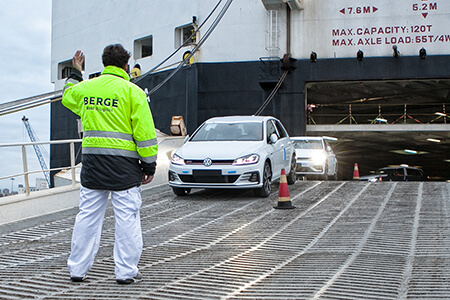 Bergé Automotive Logistics has seen an increase in its vehicle handling operations at the ports of Santander, Tarragona and Vigo
Bergé Automotive Logistics has seen an increase in its vehicle handling operations at the ports of Santander, Tarragona and VigoThe question of the UK’s separation from the EU has mixed implications for the ports, terminal operators and maritime companies, depending on where they are. Like Bremerhaven, Zeebrugge is a transhipment location for vehicles moving to and from the UK.
While numbers there were up over the year, Zeebrugge port reports that in the last month of 2017, there were 4% fewer vehicles handled compared with the same month in 2016, something it puts down to the Brexit effect, and in particular to lower sales in the UK.
“The port sees this as a warning about the growth of new vehicle traffic between Zeebrugge and the UK for the future,” it reported in the first quarter.
However, there are prospects for the port of Bristol, according to Tony Dent, who says the Bristol Port Company is forecasting that deep-sea origins and destinations will grow strongly as customers prepare for Brexit.
“As a west-coast port with traditional links with deep-sea destinations, we naturally feel we will be in a good position to accommodate additional motor vehicles of non-European origin,” he says. “Clearly, we are all waiting for more definitive information on the consequences of Brexit but we already have established routes from the Far East and America and feel there is potential for growth.”
Antwerp port says it expects little impact because it is used more as a distribution hub than for transhipments in the finished vehicle business. Likewise, little change is expected at the port of Ghent.
“For the Ghent area, we expect no big impact or only little changes as a result of Brexit,” confirms Stephanie Dierick at North Sea Port. “Companies are preparing custom-wise to trade with a third country and hope for little or no extra import/export dues. The trade itself is not expected to change due to Brexit.”
From the maritime point of view, Höegh Autoliners says Brexit is a key uncertainty factor for its business and the sector as a whole. In the absence of any firm policy, the company says it is working on “a status quo situation”, while monitoring developoments “very closely”.
“We observe that auto OEMs are not committing further investment funds to expand their UK plants due to various uncertainties,” says Simon White. “This could affect their future exports/imports volumes from/to the country.”
WWL says the consequences of Brexit are currently hard to envisage, though its spokesperson says it could be potentially more impactful for the short-sea segment. “[We] would not be at all surprised to see some production moving back from the UK to EU countries,” says White.
Grimaldi says only time will tell what the impact of Brexit will be, but according to the forecasts it could affect not only import/export trade but also European wealth more generally.
However, adds Baldissara: “We retain the view that a modern economy cannot afford any drastic stop and any Brexit effects would be mitigated somehow.”
Recovering markets
Meanwhile, there are developments underway in North Africa that are bringing benefits to ports in the Mediterranean which have lost volumes because of political instability in the Middle East and Black Sea region.
The Greek port of Piraeus is at the centre of a separate debate relating to increased port charges, but a spokesperson for the Piraeus Port Authority (PPA) says that, while political instability in the latter two regions continues to “pose challenges”, there are a number of other factors helping to boost transhipment volumes
“Piraeus has benefitted from the partial recovery of the North African markets, the increase in exports from Japan and Korea (3% and 4% respectively) and operating problems observed in critical competitive ports in the eastern Mediterranean,” says the PPA’s spokesperson. “The overall improvement in the economic climate at the international level is expected to help maintain the positive outlook for transhipment cargo.”
 The steady recovery of imports for the domestic market is showing an upward trend as vehicle registrations in 2017 recorded an increase of 20.8%, following an increase of 11% in 2016. The positive outlook for the economy for 2018 creates good prospects for further domestic demand growth.
The steady recovery of imports for the domestic market is showing an upward trend as vehicle registrations in 2017 recorded an increase of 20.8%, following an increase of 11% in 2016. The positive outlook for the economy for 2018 creates good prospects for further domestic demand growth.
In Turkey, meanwhile, the lifting of sanctions on Iran and recovery in the Russian market are expected to be of benefit to the vehicle handling ports.
“Iran was cut off from the world economy for years due to strict trade sanctions,” says a spokesperson for Efesan port. “However, Iran is starting to import European brand cars. Therefore, we expect some transit shipments via Turkey ports.”
The Efesan spokesperson adds that Russia’s bad economic position has started to improve quickly, opening up prospects for renewed trade from that direction.
Russia’s recovery is also good news for the ports in Finland, where commerical director at the port of HaminaKotka, Eija Rossi, says a difficult situation is now improving.
“The challenge has been the unpredictability of the Russian economic situation,” he says. “Now the outlook is already better, and the growth is not only for import vehicles. The operators who work with the actual vehicle flow have adjusted their activities according to the changing market environment in strong co-operation with the HaminaKotka Port.”
According to Eija, the operators in HaminaKotka port are mostly specialised in working with Russian vehicle imports. “In recent months, the positive development of the Russian economy has resulted in a slightly more positive outlook also for HaminaKotka when it comes to vehicle logistics,” he says.
Strikes in Spain
Political unrest among port workers affected business at the Spanish ports in the middle of 2017.
More than 6,000 stevedores protested in June about new laws that have technically liberalised dock services and ended the mandatory employment of unionised labour.
The action affected 39 cargo ports around the country, disrupting parts movements in and out as well as the movement of finished vehicles.
While the proposed reforms left finished vehicle stevedores out of the deregulation process, throughput at the car terminals was affected and processors had to deal with disruption. Barcelona port says it was lucky in only having one day of strike action within the week of unrest, though that nevertheless raised some alarms.
“The threat of labour unrest made most OEMs establish contingency plans by hiring more land transport beforehand, which they ended up using in the end, even though the labour problems did not transpire,” says commercial director Lluis Paris.
The carmakers, including Seat, also made efforts with their logistics providers to speed up processes for ocean-bound volumes. Seat sent cars to Mexico faster than usual ahead of the strike and emptied the temporary storage facilities it has at the Martorell plant to use for vehicles during the strike. Other carmakers prioritised and rescheduled ocean-bound volumes to avoid coinciding with planned strike days.
 The port of Barcelona expects ro-ro and car traffic to be positively affected by the resolution of recent labour negotiations
The port of Barcelona expects ro-ro and car traffic to be positively affected by the resolution of recent labour negotiationsOverall, however, Paris says the port of Barcelona suffered very little from the negotiations of new labour conditions.
“It’s important to remark that our community has been the first among all Spanish ports to get into local agreements, which we all contemplate very positively,” says Paris. “We’ll see these agreements implemented over the next few months and ro-ro and new car traffic will be very positively affected, as per the information we have.”
Alongside the stable trade with its established commercial routes, Barcelona is looking favourably on imports from the Far East, with a possible increase from Japan, new imports from South Korea and good consolidation numbers related to India.
“Mexico is also consolidating with Seat exports and Mazda imports,” says Paris, adding that a new pick-up made by Nissan in Spain will help increase exports to South Africa, Australia and New Zealand, while the east Mediterranean trade is expected to grow for imports, especially from Slovenia and Turkey.
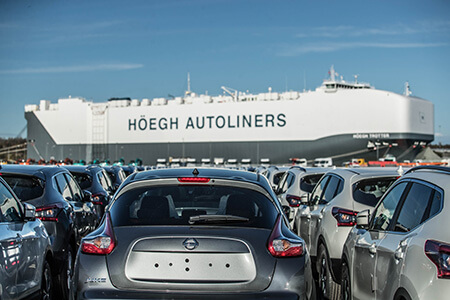 While the ports look for more room to handle increasing numbers of vehicles, providers of ocean services have shared priorities. Italy’s Grimaldi Group, plus Höegh Autoliners and Wallenius Wilhelmsen Logistics (WWL) from Norway, are each big players in European maritime finished vehicle services. They have seen increases in volumes and port calls.
While the ports look for more room to handle increasing numbers of vehicles, providers of ocean services have shared priorities. Italy’s Grimaldi Group, plus Höegh Autoliners and Wallenius Wilhelmsen Logistics (WWL) from Norway, are each big players in European maritime finished vehicle services. They have seen increases in volumes and port calls.
“Volumes have increased everywhere,” confirms Constantino Baldissara, commercial, logistics and operations director at Grimaldi. But this is leading to congestion at the ports, which is now a common pattern around Europe, he adds. The reason for this is related to increasing sales, as OEMs pay more attention to sales targets and build stocks for the long term, something in turn that is a consequence of a big change in the vehicle distribution structure, according to Baldissara.
WWL also notes rising inventory issues at the ports in Europe and says a major issue is congestion because of the longer dwell time for inbound cargo impacting on export flows.
“More markets served from respective ports also creates congestion as more sailings are required to clear the same volume,” says Simon White, chief commercial officer at WWL Ocean.
WWL says continued diversification of production, together with congestion in ports, is driving additional port calls.
“After rationalisation in the short-sea segment, there are also less feeder options available, which drives more deep-sea calls,” says White.
What is also a factor in rising inventories, according to Baldissara, is the fact that ports are being asked to provide more sophisticated services and basically serve as distribution or stocking centres. Antwerp, Portbury, Valencia, Livorno and Koper, at which Grimaldi has terminal operations, have all seen inventory rises, for example.
“This allows OEMs to distribute directly from ports (skipping double-handling in a secondary inland terminal) but also allows more flexibility in relocating unsold volumes to other markets,” notes Baldissara.
Port distribution
This diversification of production and service offering has led to a greater frequency of calls to a greater number of vehicle handling ports. While WWL is not adding many new ports, White says it is seeing more port calls on its respective routes and increased frequency to certain ports. WWL has around 15 regular ports of call in Europe and provides a feeder network connecting others. While the number of ports has remained fairly static, the frequency to the respective ports has increased. As noted, WWL operates its own terminal operations in Zeebrugge and Southampton.
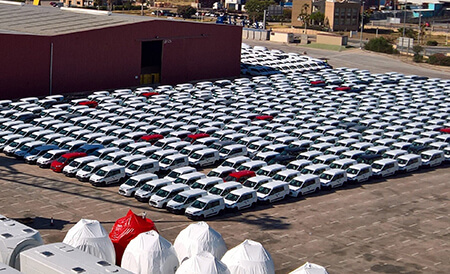 Longer dwell times are leading to rising inventories at many European ports
Longer dwell times are leading to rising inventories at many European portsBaldissara agrees that port distribution has increased in recent years, which has contributed to the burden of increasing port costs (as seen at Piraeus). Grimaldi calls at about 65 different ports in Europe (out of 120 worldwide for its annual 3m-unit volume) and provides its own terminal services at 14 of the ports in Europe, including at its group hub in Antwerp as well as at Valencia and Sagunto, and all the major vehicle handling ports in Italy.
“Most of them have been equipped for landside operations for a long time, but have increased their specialisation in the last years according to client demand,” he says.
Höegh Autoliners is well aware of this fragmentation of the market and the associated cost. The company’s chief sales officer, Trond Sjursen, says calling at more ports added time to vessel operations moving the same number of vehicles as previously (it moves 500,000 vehicles in and out of European waters and already calls at 50 ports).
Despite the added time and money that come with the greater number of port calls, WWL says it is also serving increasing demands from customers in terms of delivery performance and schedule precision.
“End-of-period whole sales targets and delivery requirements linked to financial reporting are shifting the expectations towards transport providers,” says White. “These drivers are quite removed from traditional thinking in terms of optimised delivery of vehicles to the end customer.”
Despite those demands, efficiency at many European ports has declined over the last year, according to Höegh – and that is to do with the fact that many of them are being used as storage yards.
“To our knowledge, the main reason behind this is that the OEMs use the terminals for storage of unsold cars,” says Sjursen. “This goes for both export and import cars, but the main factor is import cars now sitting in the ports for up to 45 days, compared with seven days a year ago.”
He notes examples in the northern continental ports where capacity was exceeded by more than 30% while yearly production was actually down by 10%. A result of the overflow is that the terminal operators cannot sort out the cargo on arrival any more, he says, “which causes heavy delays in vessel operation”.
“Also, the deliveries to and from the terminals are unstable due to the imbalance in traffic,” continues Sjursen.
Terminal operators, he notes, have taken several measures to improve the situation with, for instance, storage of cars outside the port areas and being more proactive when it comes to vessel operation. “Improvement has been seen, but the situation is still fragile,” he says.
WWL points out that attempts to provide the delivery precision its customers increasingly expect will continue to be undermined without an improvement in cargo throughput and consequent cargo and berth congestion at the ports.
Other trends impacting on vehicle flows and logistics at the ports in Europe include what White calls the “solid global hunger for European premium brands” and the continued development of production out of Spain and Turkey. Spain also has some growth potential for imports, he suggests.
 Northern Europe’s largest ports, including Cuxport (above), are investing in their car handling capability, storage and rail links
Northern Europe’s largest ports, including Cuxport (above), are investing in their car handling capability, storage and rail linksShift in production locations
While its own port calls remain more or less stable at 22 ports around Europe, Höegh says, one of the other drivers behind the increasing number of automotive ports in Europe is the move of automotive production towards the east and south, including locations in Slovenia, the Czech Republic, Slovakia, Hungary and Spain. Sjursen explains that this development is probably driven by lower labour and land costs, as well as generous incentives by local governments.
“Consequently, most of the new ports are being developed in the Mediterranean. Ports like Luka Koper [in Slovenia] have emerged to be an important port for several OEMs,” says Sjursen.
For Höegh, that has led to one of two significant shifts in vehicle trade flows in and out of Europe.
“We see a shift of cargo from Germany to Slovenia as the country can offer a geographical advantage for some deep-sea ro-ro flows,” says Höegh. The other main shift is the drop in cargo to the Commonwealth of Independent States (CIS) because of the collapse in oil prices and the sanctions imposed on Russia.
Investments on land and sea
New automotive infrastructure in ports is being developed in Italy (Savona, Monfalcone, Trieste and Gioia Tauro), Cyprus (Limassol) and possibly Ukraine (Chornomorsk), according to Höegh.
“As the largest ports in the north of Europe – Zeebrugge, Southampton, Gothenburg and Cuxport – and the south – Valencia and Santander – face the competition from the newcomers, we see significant investments in the expansion of their car handling capabilities, involving expansions of storage, new rail links, and other infrastructure,” Sjursen reports. Höegh itself has established its own landside services in Newcastle, UK, where it has its own terminal.
For its part, Grimaldi has tried to deal with the problem of inventory swell by trying to create more space and avoid overstocking.
“Grimaldi [has] invested much in both port space and new tonnage,” says Baldissara. “We also worked on our service structure, improving the frequency of main services and loading capacity, in order to contribute to fast logistics flows that leave port stock at acceptable levels.”
In 2017, the company took delivery of two pure car and truck carriers (PCTCs) out of a new series of ten units. The new ships have a bigger capacity than others regularly employed, reaching up to 8,000 CEU [car equivalent unit] capacity.
“Such big capacity will ease ports stocks, allowing the loading of higher and higher volumes for oceanic trades,” says Baldissara, adding that Grimaldi also invested in terminal companies at Gioia Tauro which then also became a regular call within its schedules. This gave its partners the chance to rely on important space buffers and an additional entry gate into Italy.
As already mentioned, Grimaldi is also making important investments at existing terminals in Valencia and Salerno, where multi-deck parking facilities will enhance terminal capacity.
 WWL suggests there is great potential for new technology to make processes through the ports more efficient
WWL suggests there is great potential for new technology to make processes through the ports more efficientWWL says the sector overall needs to look at vessel investment. “The current lack of new building activity should be a concern to all,” says White. “It is indicative that current returns do not justify additional capacity – and this at a time when newbuild prices are low and yards are desperate for orders. This is as unhealthy for the longer-term sustainability of the industry as the past influxes of speculative tonnage.”
WWL also points to the potential for new technology to make processes through the ports more efficient. That includes bringing transport documentation into the 21st century. “We are closely monitoring the development with, for example, the use of blockchains,” says White. “Although, we really need to see fundamental change as opposed to another medium on top of antiquated processes.”
There is also “huge scope” for gains in sharing of data and optimising flows across the supply chain, according to WWL. “From production date to delivery in port, we for the most part remain blind as to the status and flow of vehicles until they are in our custody,” says White. “Higher visibility and finding ways to optimise across the various legs remains an untapped potential for more effective planning.”
For the future
Looking ahead, Baldissara says Grimaldi is likely to register a further increase in volumes, triggered by bottlenecks at the ports affecting most finished vehicle logistics operators. However, he says this is likely to stabilise beyond 2018.
The company is also hoping for a world in which customs formalities, with the help of technology, boost logistics flows and the economy.
Baldissara also points to the merits of a more environmentally sustainable logistics model, under which only operators that demonstrate they have fleets compliant with specific quality and environmental requirements can operate.
One way it is moving towards this is by complying with the 2020 IMO sulphur emissions cap and by continuing to invest in exhaust gas treatment systems for its existing and pending fleet of car carriers, as well as looking at alternative technology.
“Nowadays, more than 30 ships of Grimaldi’s fleet sailing in the emission control areas and seven of the new PCTCs to be delivered are equipped with a state-of-art [abatement] system,” says Baldissara.
WWL is also looking at positive developments for the coming year and beyond, driven by healthy exports.
“Of an expected total production of 22m light vehicles in 2018, we anticipate Europe will export 3.8m overseas,” says White. “In the short-to-medium term, we believe exports will increase steadily with an annual growth of 3% per year, while imports into Europe are expected to develop strongly, up 200,000 units from 2017 to a total of 2.6m in 2018. Going forward, import growth is expected to outperform domestic sales growth.”
As has been well documented, WWL is also actively working to reduce sulphur emissions in the industry. The company was the founding member of the Trident Alliance in 2014, launched to collaborate on the enforcement of forthcoming maritime sulphur emission regulations, and says it will continue to take the leadership position in establishing a level playing field for operators beyond the beginning of 2020.
“WWL’s 4 Stream initiative for identifying the most effective balance of compliance solutions has provided the insights and readiness needed to give customers competitive, compliant and dependable ocean services in the post-January 1 2020 world,” says White.
Topics
- ABP
- Africa
- Antwerp Port Authority
- Asia
- Associated British Ports
- Audi
- Automar Logistics
- Autoport
- Belgium
- Bergé
- BLG Logistics
- BMW
- BMW
- Bristol Port Company
- Czech Republic
- Data
- EML
- Eukor
- Europe
- EVAG
- FCA
- features
- Finished Vehicle Logistics
- Finland
- Ford
- Ford
- GBA
- GBA
- Gefco
- Germany
- Grimaldi
- hoegh
- Hungary
- India
- International Car Operators
- Inventory management
- Iran
- Italy
- Japan
- K-Line
- Korea Rep
- Mazda
- Mexico
- Middle East
- MOL
- Neptune Shipping Lines
- Netherlands
- Nissan
- Nissan
- North America
- North Sea Port
- NYK
- OEMs
- Piraeus Port Authority
- Policy and regulation
- Port Authority of Valencia
- Port of Barcelona
- Ports and processors
- Portugal
- PSA
- Rail
- Renault
- Renault
- Republic Of South Africa
- Russian Federation
- seat
- Shipping
- Skoda
- Slovakia
- Slovenia
- Spain
- Stellantis
- Suardíaz
- Supply Chain Planning
- Toyota
- Turkey
- United Kingdom
- Valencia Port ZAL
- vauxhall
- VW
- Wallenius Wilhelmsen Logistics
- WWL
- Zealand Seaports

























![Global[1]](https://d3n5uof8vony13.cloudfront.net/Pictures/web/a/d/s/global1_726550.svgz)












